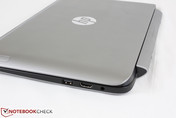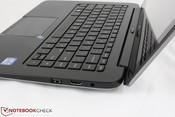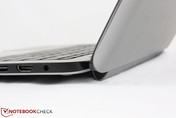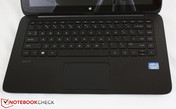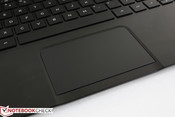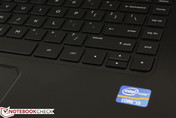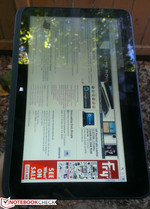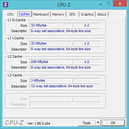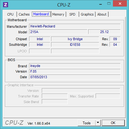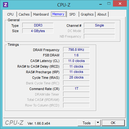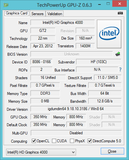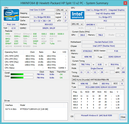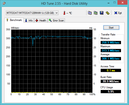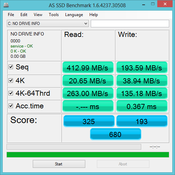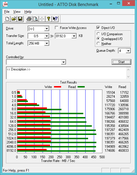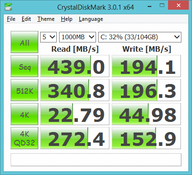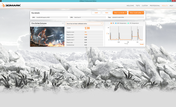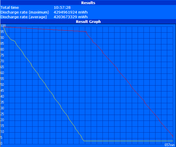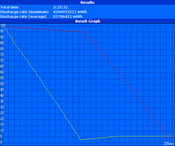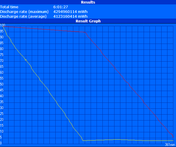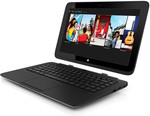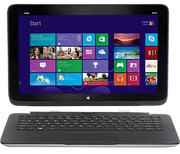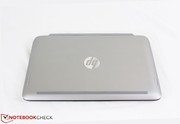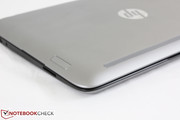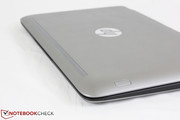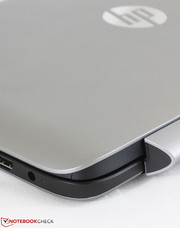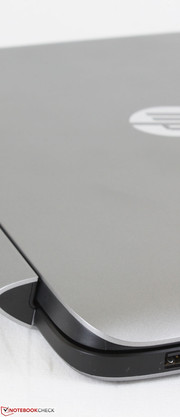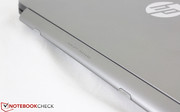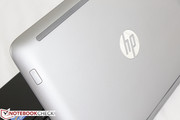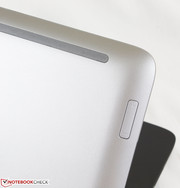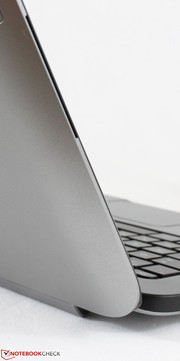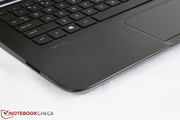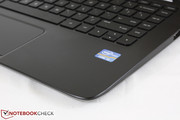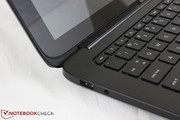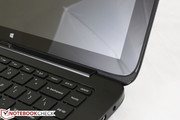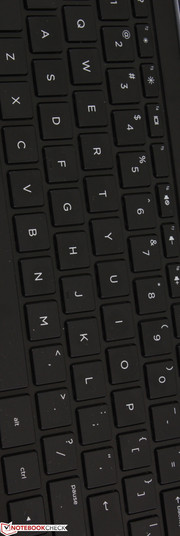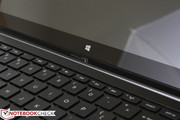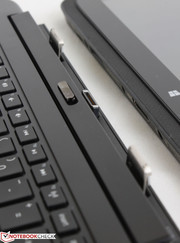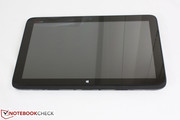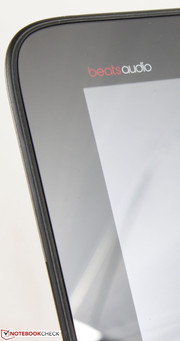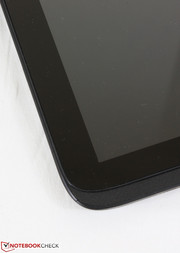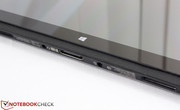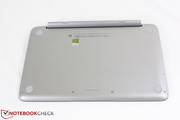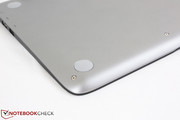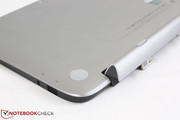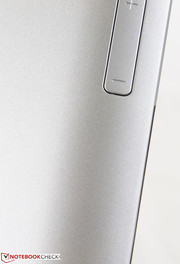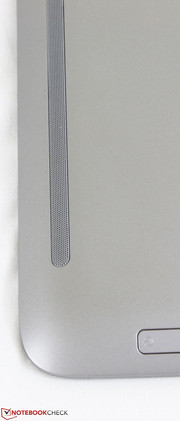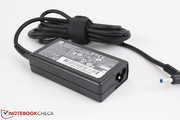Review HP Split x2 Convertible

Unveiled in May of this year, the Split x2 was in response to the success and overall positive impression that the Envy x2 left to its users. In our own review of the high-end convertible, we praised the high-quality case, long battery life, and IPS screen among other aspects of the versatility of the device.
The Envy model, however, launched for a pricey 900 Euros, which is a bit over-the-top for what is essentially an 11.6-inch convertible netbook considering the specs. The Split x2 was made with a lower price point in mind and thus targets a wider audience, hopefully without cutting too many corners in the process. The 13.3-inch convertible in review is the first available configuration of the series and is equipped with a 1.4 GHz Core i3-3229Y, integrated HD 4000 graphics, 1366 x 768 resolution touchscreen display, 4 GB RAM, 128 GB SATA III SSD and a keyboard base dock that doubles as a secondary battery with an optional 7 mm HDD. For an MSRP of $729, the model is much cheaper than the initial price of $799 when it was announced. Let’s see how it compares to the Envy x2 and other similarly-sized competing convertibles.
Case
At a combined weight and thickness of 2.3 kg (1.0 kg tablet + 1.3 kg base) and 22.9 mm (11.3 mm tablet + 11.6 mm base), respectively, the Split x2 is on the heavy side when compared to standard 13.3-inch netbooks or convertibles. The Yoga 13, Vaio Duo 13, LifeBook T902, Transformer Book TX300 and Taichi 31 – all of which are 13.3-inches in screen size – are either much thinner or lighter or even both. The weight difference can be partly attributed to the secondary battery of the Split x2 for potentially longer battery lives than the competition, but there is no denying that the HP convertible is certainly weighty for the size.
Consequently, the heavy build has resulted in good construction quality all-around. We were a bit worried that case quality may have taken a hit due to the “cheapening” on the original Envy x2 design, but we’re pleased to say that both the tablet and base portions exhibit better-than-average resistance to finger depressions and twisting. Rigidity is not as good as the Envy x2, for example the backside of the tablet can still be depressed down the center. The base does show a bit more flexing than the tablet around its edges, keyboard center and palm rests, but it’s certainly not a cause for concern.
Unfortunately, the two connecting hinges that attach the tablet to the base allow for far too much wobbling. When the display is set at a comfortable angle, the hinges are simply not stiff enough to secure the screen from tilting back and forth. This isn’t so much of a problem when using the convertible on a flat desk, but we certainly would not trust transporting the device without closing the lid first. Like other tablet convertibles such as the Lenovo IdeaTab S2110, the top-heavy tablet portion can be a bit too much for the hinges if not careful. Though adequate, the locking mechanism here leaves room for improvement.
Visually, the Split x2 is similar to the Envy x2 in terms of color and smooth textures with a couple of major differences. Firstly, the keyboard surface is now black and a fingerprint magnet with a more obvious inexpensive plastic compared to the higher-quality lid and base. Secondly, the brushed aluminum surface of the Envy x2 is now matte silver plastic that can scratch quite easily. Combined with the thicker chassis, the Split x2 doesn’t look nearly as luxurious as its smaller-but-older brother, though we have to commend HP’s successful efforts in maintaining much of the rigidity and structural construction of the original.
Connectivity
The tablet portion itself houses little connectivity options – even a USB port is conspicuously absent. It does, however, have a local microSD reader, headphone jack and AC power adapter, all of which are located on the bottom edge alongside the proprietary dock pins. Consequently, this also means that all ports will become inaccessible once the tablet is connected to its station. This is not an issue for the power or headphone ports as the dock includes its own set as well, but users will need to detach the base if physical access to the microSD card is required.
Speaking of the base, the unit provides 2 USB ports, an HDMI port and an SD reader. The options are almost identical to the Envy x2 and a bare minimum with regards to ultraportables; An Ethernet port, additional USB port or VGA port would have been great additions. Nonetheless, it does feel a bit odd to have a tablet with no local USB ports available.
Communication
Wireless 802.11n is provided by a dual-antenna Ralink RT3290 module with integrated Bluetooth 4.0. Future models are expected to carry a Broadcom 4352 module for 802.11c connectivity should the user support it. Don’t expect integrated GPS or WWAN functionality anytime soon since the Split x2 is clearly a consumer-oriented device and not a target for business users. We ran into no connectivity issues or random drops during our time with the dock and tablet.
Accessories
The package includes nothing else in terms of accessories beyond the standard setup instructions, warranty information and a Windows 8 Basics guide. There are no dedicated accessories either since the consumer convertible is meant to be fully featured as-is. Users can still connect generic USB-based extensions should they require additional ports or optical drives.
Warranty
The standard 1-year parts and labor is included with every purchase. This does not include onsite service or accidental damage, but out-of-warranty users can still receive help online from HP’s Consumer Support Forums, Support Videos or Customer Care or even reapply for warranty under HP’s Care Pack Service. If still under warranty, HP provides the option to extend for premium care, onsite services or pick up and return programs.
Input Devices
Keyboard
The matte plastic chiclet keyboard (28.5 cm x 10 cm) on the dock shows no issues in terms of responsiveness while typing. Note that travel is very shallow and feedback feels very light (similar to the Envy x2 keys), so it may take some time to become fully accustomed to the “featherweight” feel of the keys. The narrower top row of function keys feel notably mushier than the QWERTY set and the split Up and Down directional keys can be difficult to use precisely for larger fingers. The lack of a keyboard backlight is to be expected as the more costly Envy x2 skipped this feature as well.
Touchpad
The Synaptics matte touchpad is capable of recognizing up to 4-finger inputs for Windows 8 Edge Swipes, rotation, scrolling and flicking. It may not be very large (9.5 cm x 6 cm), but its size suitably fits the chassis and is responsive to basic point and clicks as well as multi-touch commands with minimal misreads. Zooming still feels a bit slow and delayed compared to Android devices, though that may be more software-related than hardware. If an external mouse is detected, the touchpad will automatically disable.
Since the display is a touchscreen, many of these same commands can simply be performed directly on the screen itself. In this case, we ran into no issues with inaccurate input recognition or delays between scrolling, swiping or snapping windows in and out of focus.
Display
A standard 13.3-inch 1366 x 768 resolution glossy display comes standard on the Split x2 with no other available options. HP claims a contrast ratio of 200:1 and up to 262,144 colors from the glass screen, the former of which is close to our measured contrast of 256:1 on the very center of the screen. The LED backlight is also a bit weaker than the advertised 200 nits at a measured 170 nits on average. This decreases even further to 140 nits if running on batteries, even if on the High Performance profile.
Nonetheless, the screen itself is average at best in terms of display quality. Because of the large size, low pixel density (118 PPI) and the tendency to have tablets closer to the eyes during use, individual pixels are easy to discern. The low contrast becomes very obvious when viewing videos with dimly lit scenes as black spots appear muddy and gray. Furthermore, the TN panel is a downgrade and a likely cost-saving measure compared to the outstanding IPS display of the Envy x2. As a standalone tablet, the display of the Split x2 is outclassed by almost all available tablets from major manufacturers. In this regard, the HP model has the upper hand only in terms of physical display size.
| |||||||||||||||||||||||||
Brightness Distribution: 93 %
Center on Battery: 140 cd/m²
Contrast: 256:1 (Black: 0.665 cd/m²)
ΔE Color 4.16 | 0.5-29.43 Ø5
ΔE Greyscale 4.09 | 0.57-98 Ø5.3
44% AdobeRGB 1998 (Argyll 1.6.3 3D)
47.08% AdobeRGB 1998 (Argyll 2.2.0 3D)
67% sRGB (Argyll 2.2.0 3D)
45.4% Display P3 (Argyll 2.2.0 3D)
Gamma: 2.41
Color space reproduction covers about 64 percent of the sRGB standard and subsequently even less of the AdobeRGB spectrum, which is common amongst budget displays. The majority of consumer-oriented notebooks exhibit similar coverage such as the Dell XPS 12 and Lenovo Twist below, but this should not be a concern for the average household user where color reproduction is normally not a huge factor.
Further display measurements were performed with an X-Rite i1Basic Pro 2 spectrophotometer. Color accuracy before calibration is middling with a deltaE average of over 8 units. Fortunately, the deviation becomes much smaller the more saturated the colors become, though Blue, Cyan and Magenta show little improvement. Colors and even grayscale after calibration become much more normalized across the board, especially Cyan and the correlated color temperature.
Outdoor usability is average at best due to the combination of poor contrast, a glossy display, large screen size and low screen brightness. Higher brightness levels are typically expected from tablets when compared to notebooks, but the Split x2 is simply not bright enough for comfortable use under broad daylight or even shade. If unavoidable, maximum brightness is highly recommended and font size should be increased during longer sessions to reduce eyestrain. With that said, the Split x2 is clearly intended for mostly indoor use.
As stated above, HP’s decision to outfit the Split x2 with a TN panel instead of an IPS panel as found on the Envy x2 and most other major tablets have adversely affected viewing angles. Users familiar with the budget Lenovo IdeaTab A2109A or A1000 tablets will immediately realize that the Split x2 will become more difficult to use in portrait mode as opposed to its default landscape mode. The distance between the eyes of the user is enough to notice the color shifts typically associated with TN panels if in this orientation. Thus, the Split x2 was designed to be used in one orientation only – with the Windows Home button on the bottom. It is still possible to use the tablet in other modes and the display will still automatically rotate accordingly, though the default landscape mode is highly encouraged.
Performance
The model in review uses a Core i3-3229Y Ivy Bridge CPU with integrated HD 4000 graphics. The 1.4 GHz ULV processor is rated for 13 Watts TDP and includes no Turbo Boost. In contrast, the GPU benefits from Turbo Boost up to 850 MHz, though this is short-lived as detailed in our stress test section below. When idle and in Power Saver mode, the CPU and GPU in the Split x2 will operate at 800 MHz and 350/800 MHz (core/memory), respectively. Future models will take advantage of faster Intel ULV processors including the i5-3339Y and Haswell i3-4010Y and i5-4200Y models with Integrated HD 4400 graphics and Turbo Boost potential. For more information and benchmarks on the i3-3229Y, see our dedicated page here.
RAM is provided by a single-channel PC3-12800 DDR3L 4 GB module. Models with 8 GB of RAM are expected to be available soon. The single SODIMM slot is user-removable as are other components including the mSATA drive and the half-mini PCI-e WLAN card. The battery, RTC battery, fan and antennae are accessible as well. The back cover of the tablet can be carefully popped off after removing a set of two Philips screws next to the docking pins. It is challenging to open without damaging the sides of the tablet, but we certainly commend HP for allowing access to internals, which is something sorely missing from most other tablets and many convertibles.
Processor
CPU performance is most similar to the previous generation Sandy Bridge ULV Core i3-2377M. As examples, the single-threaded Super Pi 32M benchmark completes in 1401 seconds vs. 1338 seconds in the i3-2377M and the multi-threaded wPrime 1024M benchmark completes in 1220 seconds vs. 1141 seconds in the Sandy Bridge equivalent. CineBench scores are also slightly better for the older model compared to the i3-3229Y. Instead, the improvements that the newer IVB model brings are not related to raw performance, but performance-per-Watt. The i3-3229Y is still very close in performance while consuming less power (13 W TDP vs. 17 W TDP) and operating at a lower clock rate (1.4 GHz vs. 1.5 GHz) than the i3-2377M. The ULV Core i3 here is a great balance for those wanting more power than both Atom CPUs and ARM-based SoCs without losing too much battery life from much more powerful standard voltage mobile Core i3 or i5 solutions.
System Performance
A final score of 3366 points in PCMark 7 is very good for a mainstream convertible. There is no doubt that this was boosted by both the OOE ULV Core CPU and SATA III SSD as competing Windows tablets with slower Atom processors (ex., IdeaTab Lynx K3011 and ThinkPad Tablet 2 with 1435 Points and 1437 points, respectively) stand no chance against the Split x2. The Windows 8 Experience Index implies a system somewhat bottlenecked by the processor and integrated graphics relative to the fast SSD. As newer Split x2 models become available with faster CPU options, however, we expect the system to become more balanced in terms of hardware.
Subjectively, performance is fast when navigating between windows and opening apps. The feeling isn’t as snappy as say a DTR with RAID 0 SSDs, especially when launching programs for the first time as loading will still take a couple of seconds, but system responsiveness is leagues beyond an HDD-based convertible of Ultrabook as expected.
| PCMark 7 Score | 3366 points | |
Help | ||
Storage Devices
Up to two drives can be installed in the Split x2 – one in the tablet itself (SATA III mSATA) and a secondary in the docking station (7 mm SATA). Our model uses a 128 GB primary mSATA SSD from Micron (MTFDDAT128MAM-1J2) with no pre-installed secondary, though users can access the drive bay in the docking station after removing a few Philips screws. Users must also be careful when detaching the base from the tablet should the device be accessing the secondary drive or SD card. It’s easy to forget and doing so would risk damaging the storage drives and will even invoke an onscreen warning message.
Performance from the Micron drive is very good with fast read speeds according to CrystalDiskMark. The manufacturer rates this particular drive for a theoretical 500 MB/s read and 260 MB/s write, both of which are about 60 MB/s higher against our recorded numbers. Sequential write speeds, however, are less than half of the read speed and could have been much higher. This is reminiscent to the Crucial M500 CT120M500SSD3 where its write speed can be many times greater than its read speed (488.1 MB/s vs. 137.5 MB/s), something that is generally more common amongst mSATA drives including those from Samsung (MZMD128HAGN) and ADATA (XPG SX300). Impact from the transfer differences on everyday performance is fortunately low and almost negligible, especially for such a low-power convertible like the Split x2.
Gaming Performance
PC gaming on a tablet is not exactly mainstream just yet and users shouldn't be surprised at the subpar graphics performance of the Split x2. Compared to the average HD 4000 GPU in our database, the GPU in the Split x2 is below average due to its ULV CPU and reduced GPU Turbo Boost potential. As an example, Guild Wars 2 and Starcraft 2 run at 22 FPS and 70 FPS at their lowest settings, respectively, while the average HD 4000 across all benchmarked notebooks can run these same games at 36 FPS and 111 FPS under the same settings. Beyond casual gaming at very low settings or Flash games, the Split x2 is not capable of playing many of today's popular PC titles.
The final 3DMark 11 score of 425 points places the Split x2 right next to other notebooks sporting the same GPU paired with similar ULV IVB processors. This includes the Acer Aspire S3-391 (421 points) and Fujitsu Lifebook U772 (425 points) with a Core i5-3317U and Core i6-3427U CPU, respectively. Compared to, say, a ThinkPad Edge E431 with the same GPU on a standard voltage CPU, the Split x2 is slower by nearly 150 points in the same benchmark.
| low | med. | high | ultra | |
| Guild Wars 2 (2012) | 21.6 | 7.3 | ||
| StarCraft II: Heart of the Swarm (2013) | 70 | 20.8 | 11.4 |
| 3DMark 06 Standard Score | 2885 points | |
| 3DMark Vantage P Result | 1842 points | |
| 3DMark 11 Performance | 425 points | |
| 3DMark Ice Storm Standard Score | 22503 points | |
| 3DMark Cloud Gate Standard Score | 2247 points | |
| 3DMark Fire Strike Score | 321 points | |
| 3DMark Fire Strike Extreme Score | 138 points | |
Help | ||
Emissions
System Noise
More often than not, we skip this section for tablets as they almost always emit no system noises. The Split x2, however, utilizes active cooling via a system fan with accompanying heat pipes and long vent grilles near the top of the backside. In fact, system noise is not all that different from many standard netbooks or ultrabooks according to our measurements below.
When the notebook is completely idle, we were able to record sound levels of about 32 dB(A). This is essentially inaudible under typical conditions and is only a slight hum under the quietest circumstances. Browsing, word processing and other light multi-tasking loads will not bump fan speeds any higher than its base level, so the convertible is still nearly silent despite the active cooling. Even so, the Split x2 isn’t afraid to increase fan RPM as needed. Higher CPU and GPU loads will increase fan speed in step increments from the base 32 dB(A) to 35.3 dB(A), 38.4 dB(A) and finally 40.8 dB(A) in the most extreme circumstances. HD videos will occasionally bump the fan to 35.3 dB(A) for short periods of time. Despite this, we never found system noise to be distracting under normal everyday use.
Noise Level
| Idle |
| 32.2 / 32.3 / 32.4 dB(A) |
| Load |
| 35.3 / 40.8 dB(A) |
 | ||
30 dB silent 40 dB(A) audible 50 dB(A) loud |
||
min: | ||
Temperature
A tablet with a fan doesn’t necessarily translate to lower surface temperatures as demonstrated by our measurements below. The nearly 38 degrees C hotspot on the back corner of the tablet is easily felt and identifiable simply from the system idling. During extended use, a temperature difference between the left and right hand will become very obvious and can be slightly distracting after some time. The high surface temperature is uncommon for idling tablets and convertibles with notable examples being the Lifebook T902 and the Envy x2.
When under maximum load, we were able to record temperatures of about 46 degrees C on the same hotspot or an almost 10 degrees rise in surface temperature. This can certainly become uncomfortable, though we note that our load measurements represent unrealistic CPU and GPU stress conditions that do not typically occur under everyday usage. Even so, we recommend attaching the dock for extended sessions to avoid directly handling a potentially very warm tablet. Since all major components are located in the display itself, the base will remain relatively cool no matter the workload with a more or less uniform temperature both on the keyboard and bottom. A >40 degrees C surface is common for notebooks under stress, but users will naturally notice the temperature change much more quickly with a tablet on hand.
(-) The maximum temperature on the upper side is 46.4 °C / 116 F, compared to the average of 35.3 °C / 96 F, ranging from 19.6 to 55.7 °C for the class Convertible.
(-) The bottom heats up to a maximum of 46.6 °C / 116 F, compared to the average of 36.8 °C / 98 F
(±) In idle usage, the average temperature for the upper side is 33.7 °C / 93 F, compared to the device average of 30.2 °C / 86 F.
(±) The palmrests and touchpad can get very hot to the touch with a maximum of 36.2 °C / 97.2 F.
(-) The average temperature of the palmrest area of similar devices was 28.1 °C / 82.6 F (-8.1 °C / -14.6 F).
Stress Test
We stress the CPU and GPU in our convertible while having CPU-Z, GPU-Z and HWiNFO monitoring tools running to identify any potentially throttling or stability issues. With only Prime95 active, the CPU was seen operating at its maximum 1.4 GHz as advertised. Occasionally, the core will dip to 1.2 GHz, but will quickly jump back to its rated 1.4 GHz rate. With only FurMark active, the GPU was running at 850/800 MHz (core/memory) and very quickly dropped and stabilized to 500 – 550 MHz core after just a few seconds. Though the HD 4000 may be rated at 350 MHz with Turbo Boost up to 850 MHz, it is not uncommon for ULV processors to have the integrated GPU run at lower Turbo Boost frequencies due to a lower TDP overhead.
When under maximum stress with both Prime95 and FurMark active simultaneously, both the CPU and GPU were observed to be running smoothly at 800 MHz and 350 MHz, respectively, and never any higher. Fortunately, both cores never fell below these base frequencies either, suggesting no major throttling issues despite its tablet form factor. We note that the GPU load was seen fluctuating between 83 percent and 100 percent according to GPU-Z, which also suggests a power bottleneck preventing full utilization of then GPU when the CPU is under stress. At the end of the stress test, the CPU core was a recorded 70 degrees C and a 3DMark 11 run immediately following the test returned no statistically significant changes in final scores (425 before stress vs. 421 post stress).
System performance is not reduced when running on battery power. Both the CPU and GPU are able to maintain their respective clock rates and a 3DMark 11 run on batteries again returned no statistically significant changes in final scores (425 before stress vs. 424 on batteries).
Speakers
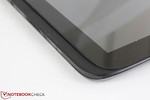
The Beats Audio branding was at first exclusive to high-end Envy models but has since made its way down to mainstream HP devices. The two integrated stereo speakers are located along the corner grilles on the front of the tablet close to the bottom edge.
Sound quality is acceptable for a tablet albeit a too muffled for a satisfactory movie or music experience. It certainly lacks the “tinny” quality that most tablets and netbooks suffer from due to their very small speakers, but the range on the Split x2 is low and feels imbalanced even at the 50 percent volume range. Maximum volume is fortunately very loud with no static or noticeable increase in distortions. For extended sessions, external solutions are recommended.
When using the tablet in the landscape orientation, both the Volume rocker and Power button are positioned in such a way that the user can easily adjust volume or power down with the index or middle fingers. This can also lead to unintended sleep or volume changes if the user is not careful, such as when picking up the device from a table or handing it to others to use.
Battery Life
Unlike say the IdeaTab S2110, the Split x2 utilizes a primary 3-cell 33 Wh Li-polymer battery as well as a secondary 3-cell 32 Wh Li-polymer located in the dock itself. Though accessible by removing their respective back panels, the modules are not meant to be removed or replaced in a convenient manner. The primary battery is larger than the 26 Wh equivalent in the Envy x2 and its combined 65 Wh of power is more than the Taichi 31 (53 Wh), Yoga 13 (54.7 Wh) and Vaio Duo 13 (47.4 Wh), but smaller than the Lifebook T902 (72 Wh).
Our battery life tests were performed with the dock connected and since the battery module in the dock is roughly the same as the module in the tablet in terms of capacity, halving our results below will give a good idea of how long the tablet can last just off of the primary.
When under ideal battery runtime conditions (Power Saver mode, minimum brightness with no timeout, and inactive wireless), the Split x2 was able to last for almost 11 hours. Our more realistic WLAN condition puts the convertible in Balanced mode at a brightness as close as possible to 150 nits – in this case, the maximum brightness setting – while looping our standard script to simulate typical browsing conditions. The unit was able to last for 6 hours before automatic shutdown.
The large discrepancy between the idling and WLAN runtimes show that users should be able to squeeze at least an hour or so more from the batteries with low usage and more reserved battery-saving system settings. Our measured 6 hours during constant WLAN use is certainly longer than the 4-5 hour Taichi 31, LifeBook T902 and IdeaPad Yoga 13, but comes a bit short compared to the Vaio Duo 13 and especially the IdeaTab S2110 and Envy x2. The latter two can be explained by their extremely low-power Snapdragon and Atom processors compared to the i3-3229Y in the Split x2.
Verdict
We loved the Envy x2 because of its versatility as a relatively small convertible with a high quality IPS screen. Unfortunately, the Split x2 has lost too many features that made the Envy x2 great in the first place, most of which are related to the screen itself. The budget TN display, more limiting viewing angles, low brightness, low contrast, and low DPI all contribute to a tablet that simply isn't as rewarding to use. Especially for a price north of $700 USD, almost all tablets below this price point provide better displays for a more enjoyable experience.
From a netbook point of view, the Split x2 is good in terms of system performance due to the ULV i3 CPU, but again, the $700+ price point is a bit high for a heavy netbook. Ultrabooks are now less expensive than they were previous years and are much thinner and lighter for easier use on-the-go. The weight, size, and middling display all prevent the Split x2 from being an outdoors device.
With that said, the HP convertible is fun to use around the house and for kids as a multimedia device, especially with the large 13.3-inch touchscreen. It's subpar compared to standalone tablets or netbooks and subsequently suffers from the "jack of all trades, master of none" syndrome. We would love to see future models come equipped with IPS displays for an easier recommendation. Until then, this Windows convertible is a tougher sell against the likes of the Yoga 13, Samsung ATIV Smart PC, Acer Iconia W510, Toshiba U920t, Dell XPS 12 and other dual-purpose notebooks.


 Deutsch
Deutsch English
English Español
Español Français
Français Italiano
Italiano Nederlands
Nederlands Polski
Polski Português
Português Русский
Русский Türkçe
Türkçe Svenska
Svenska Chinese
Chinese Magyar
Magyar